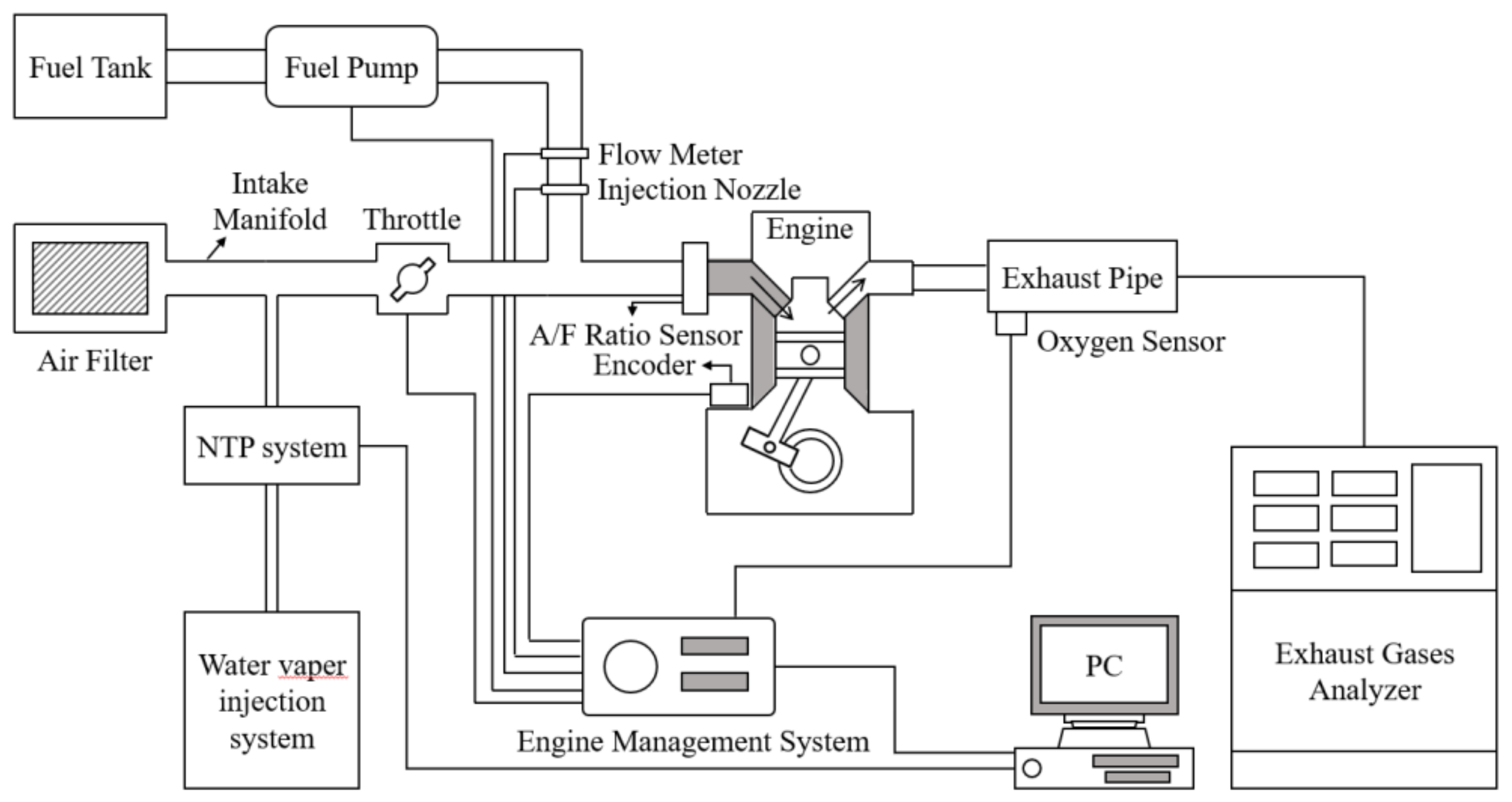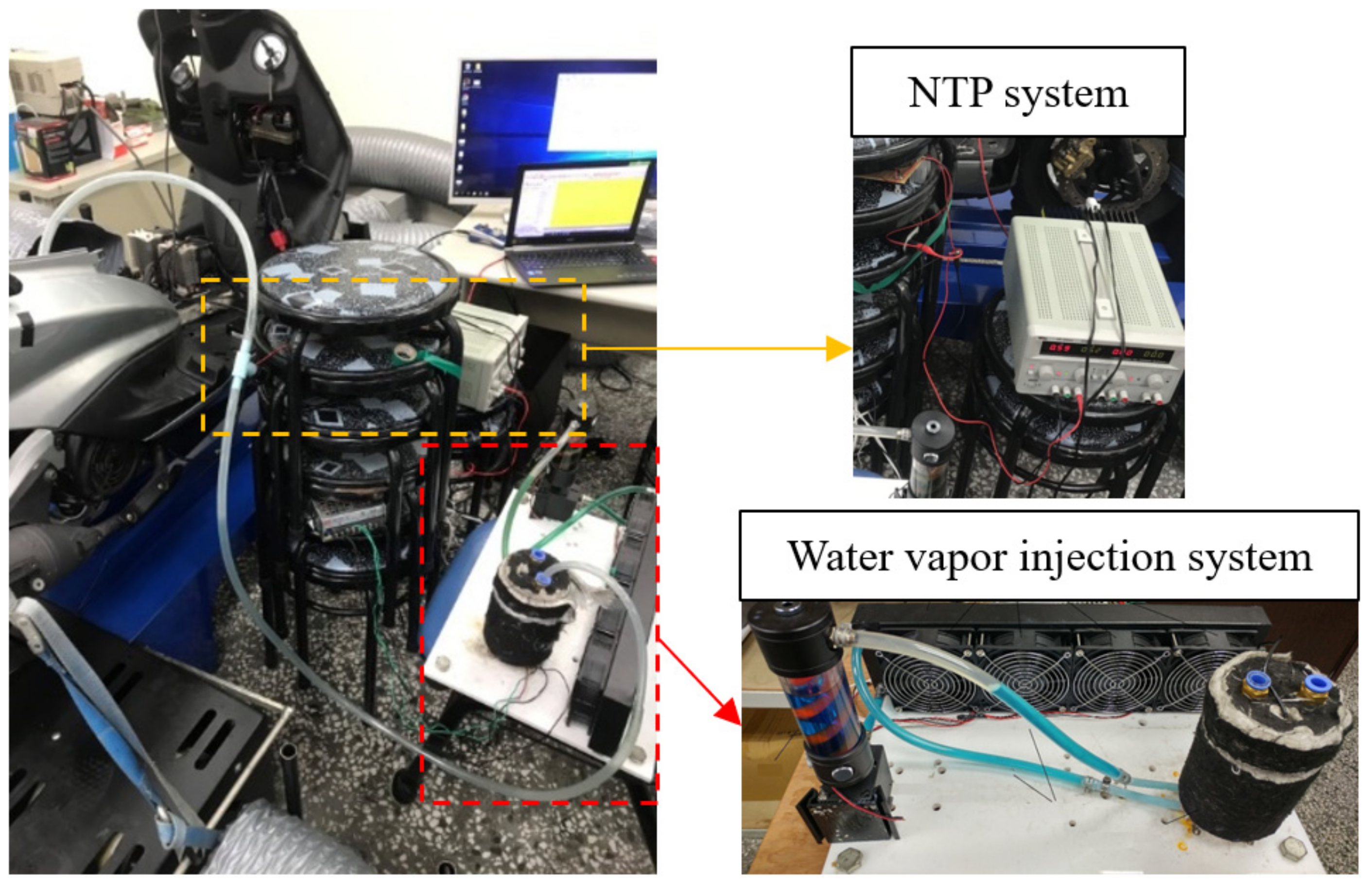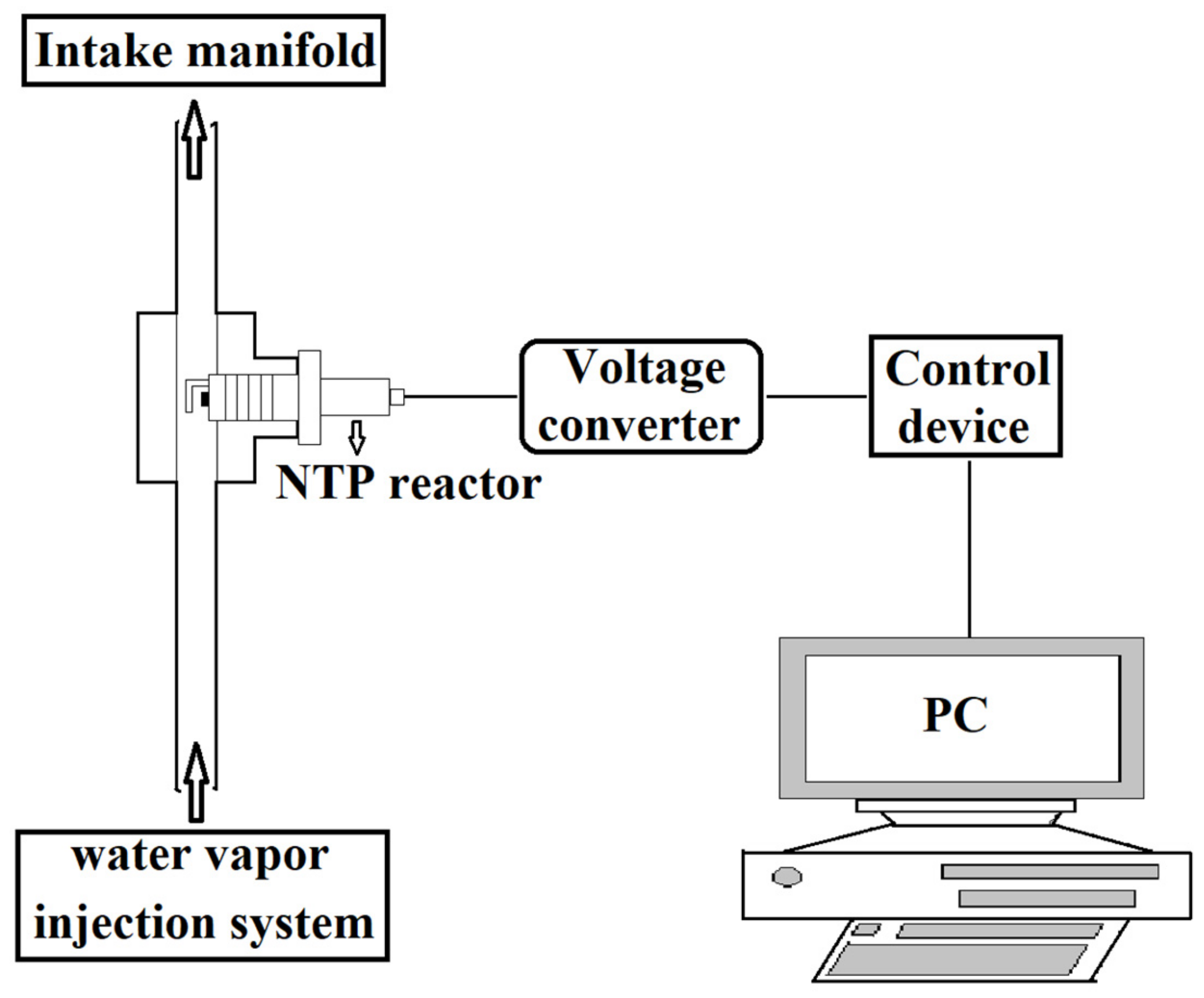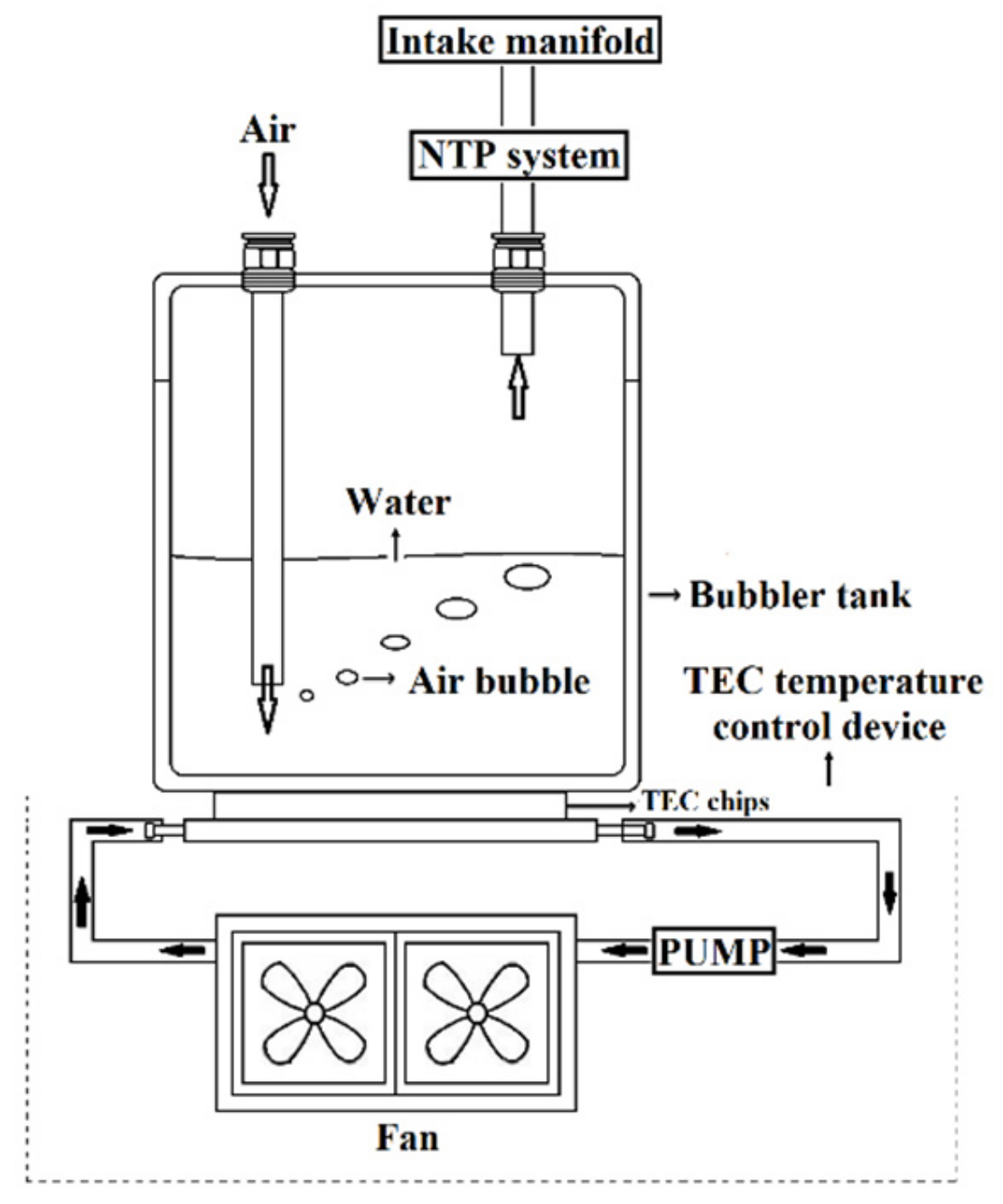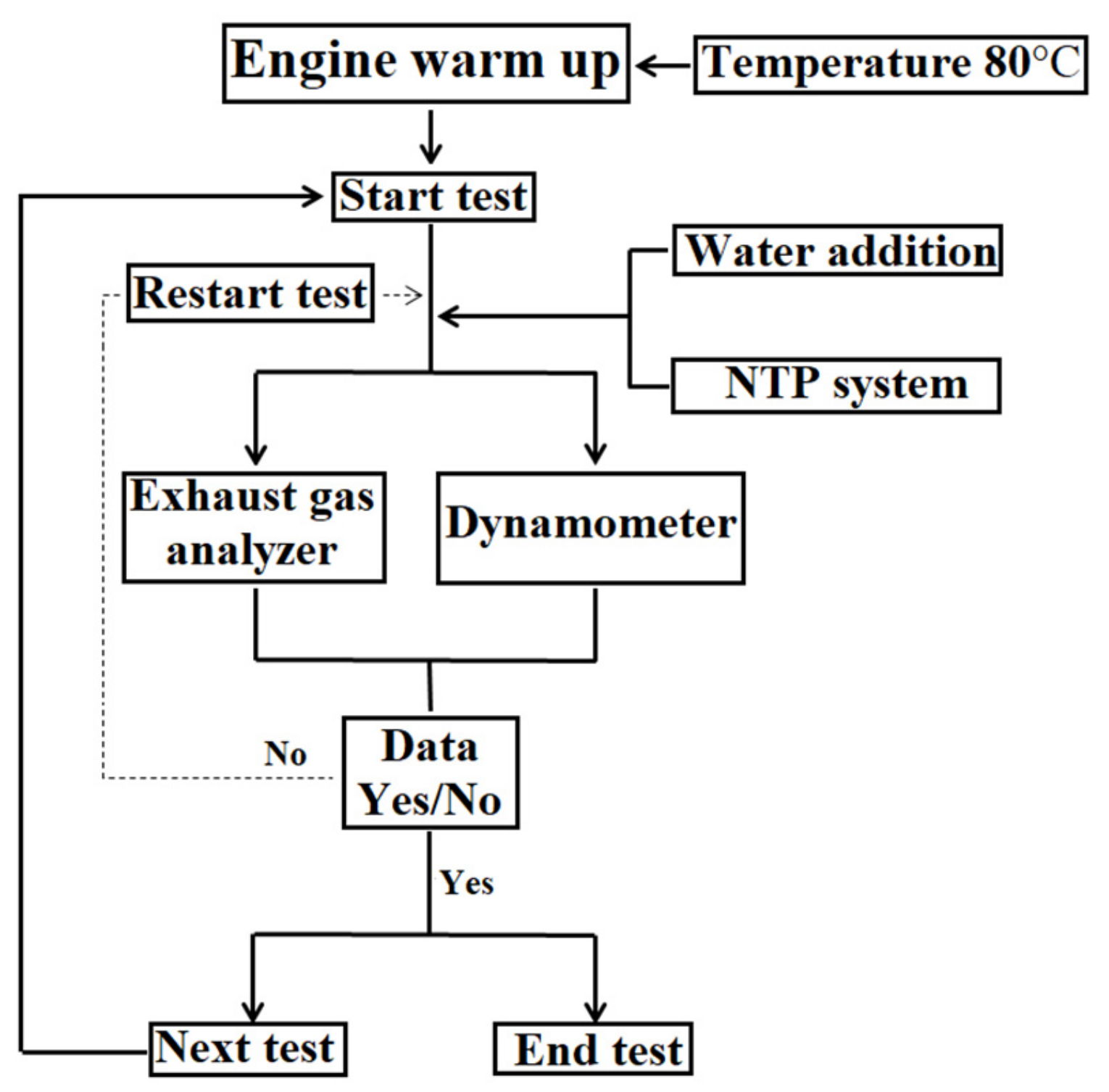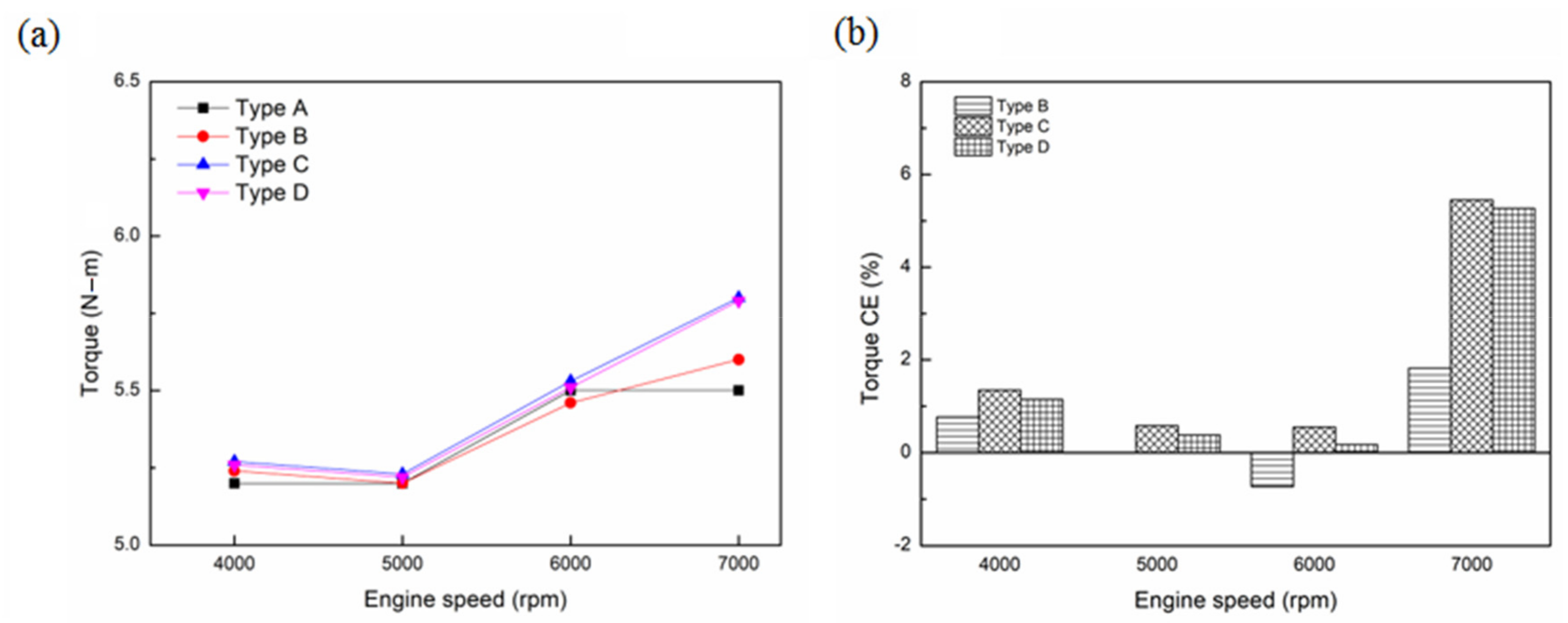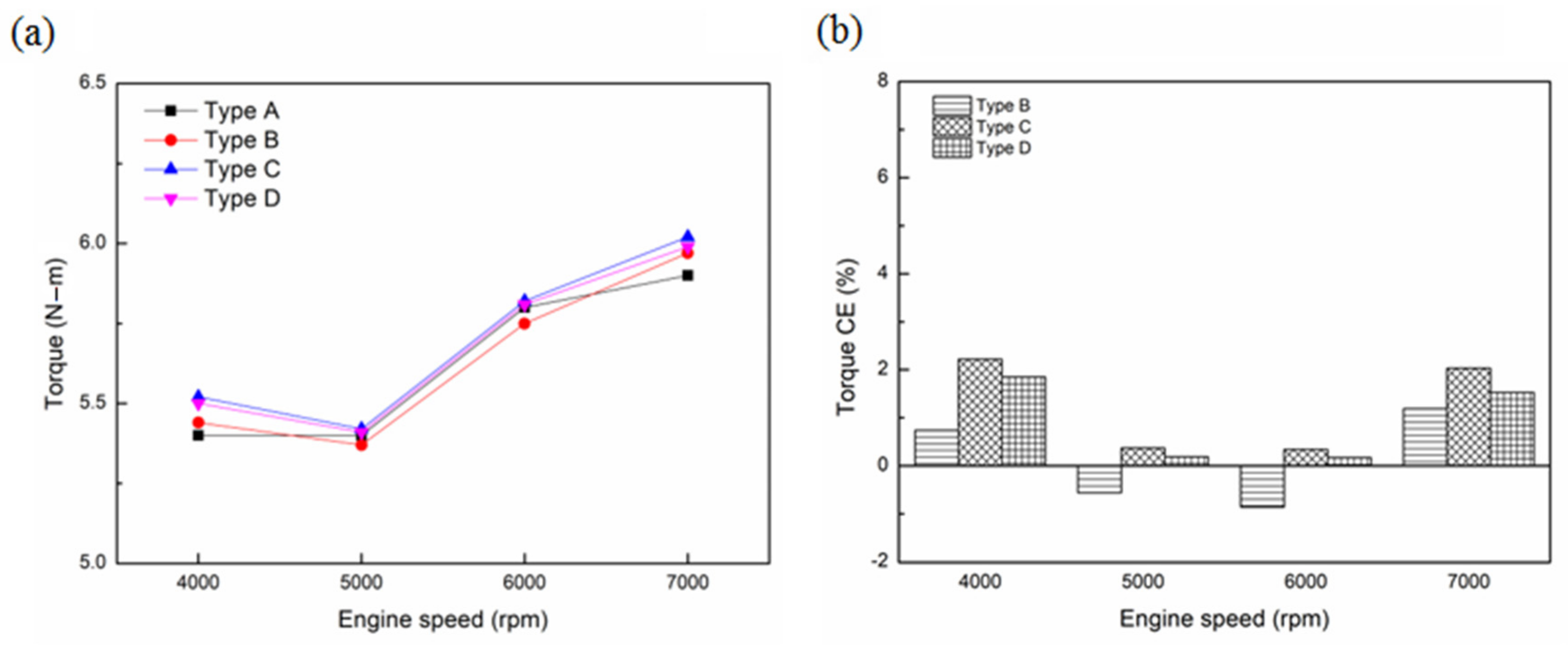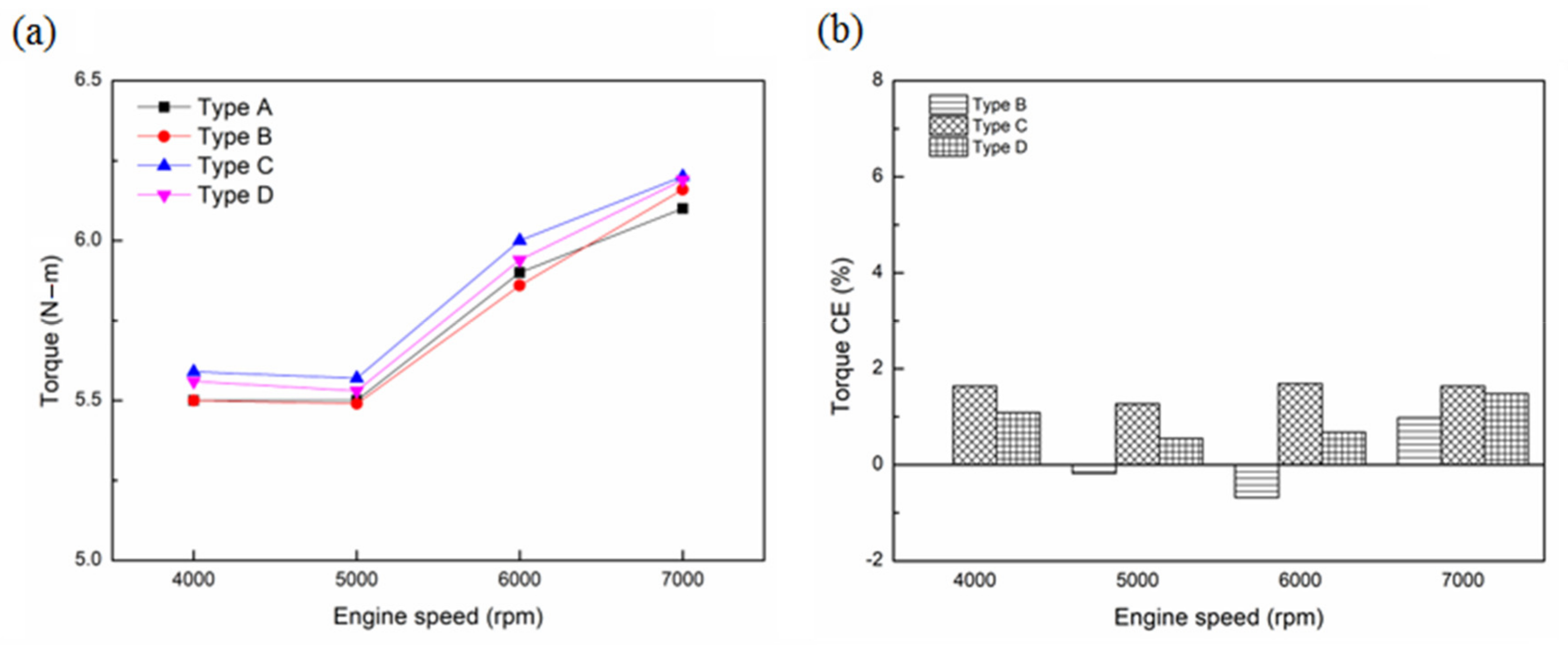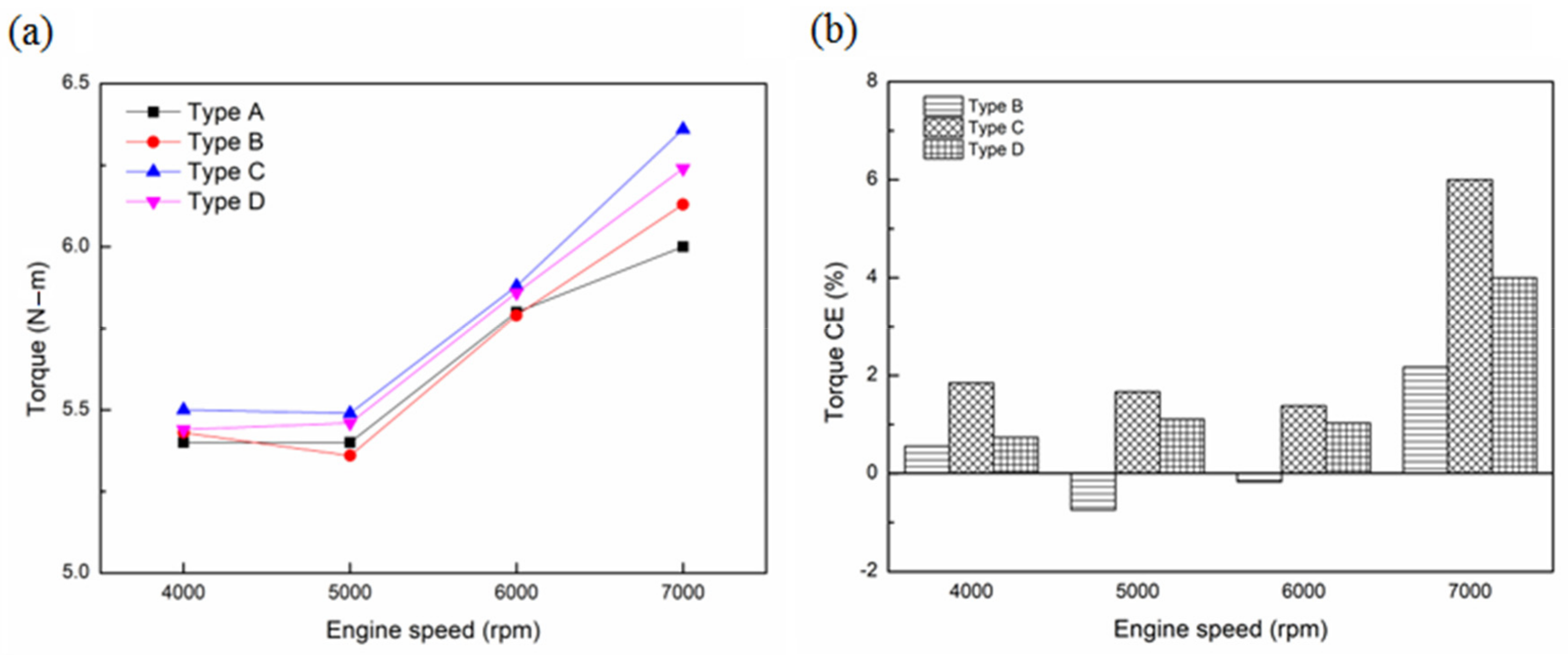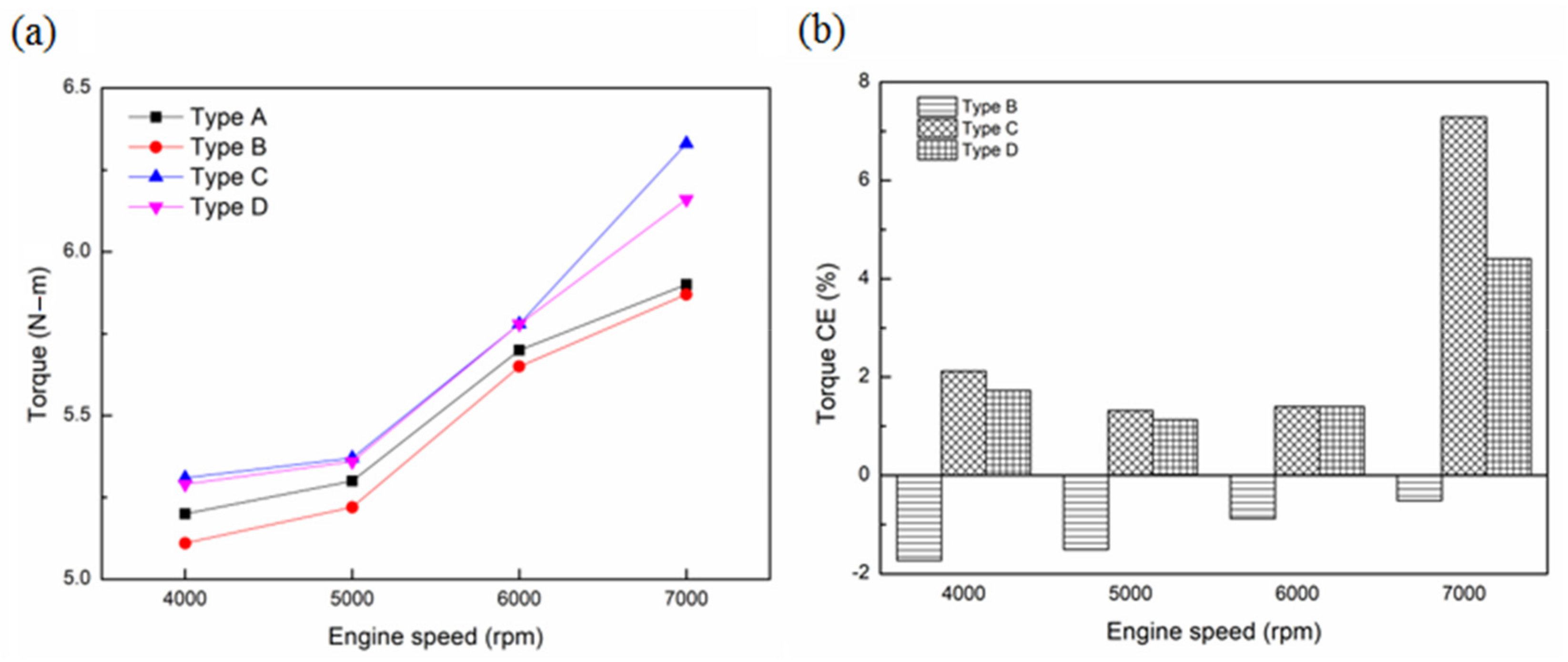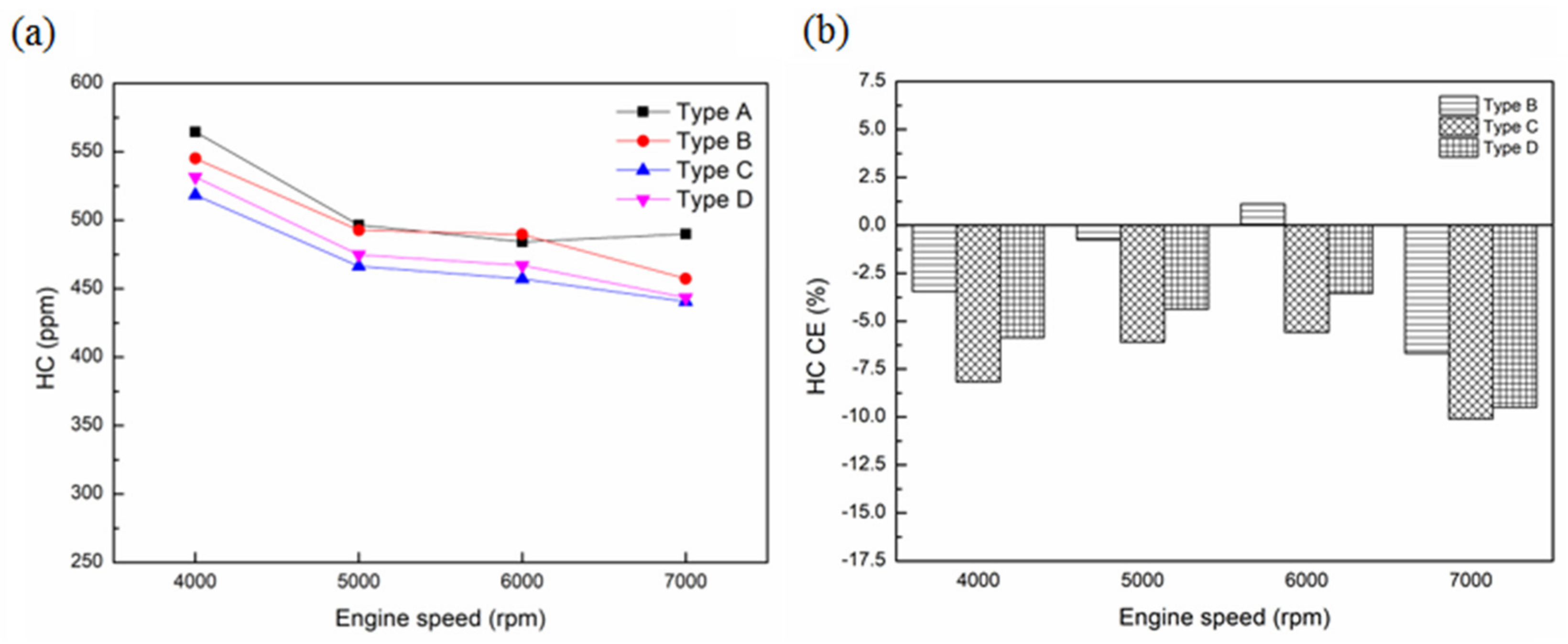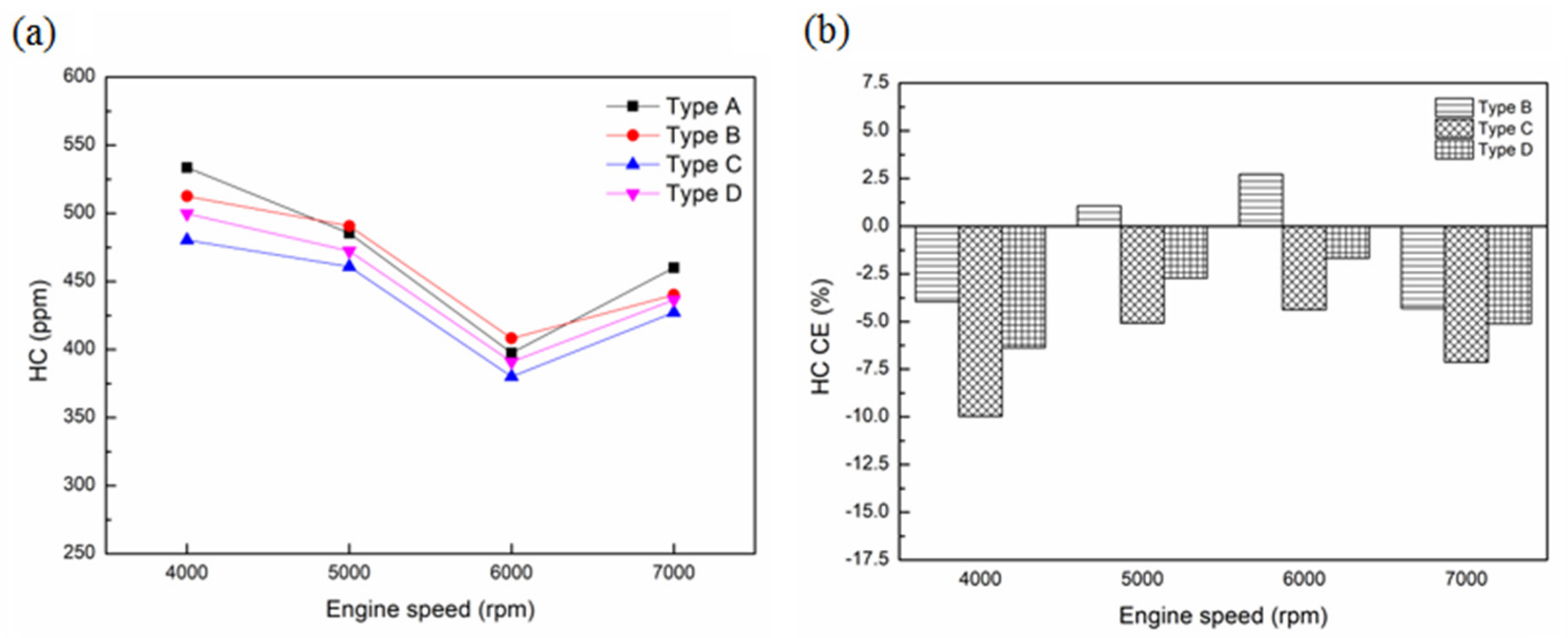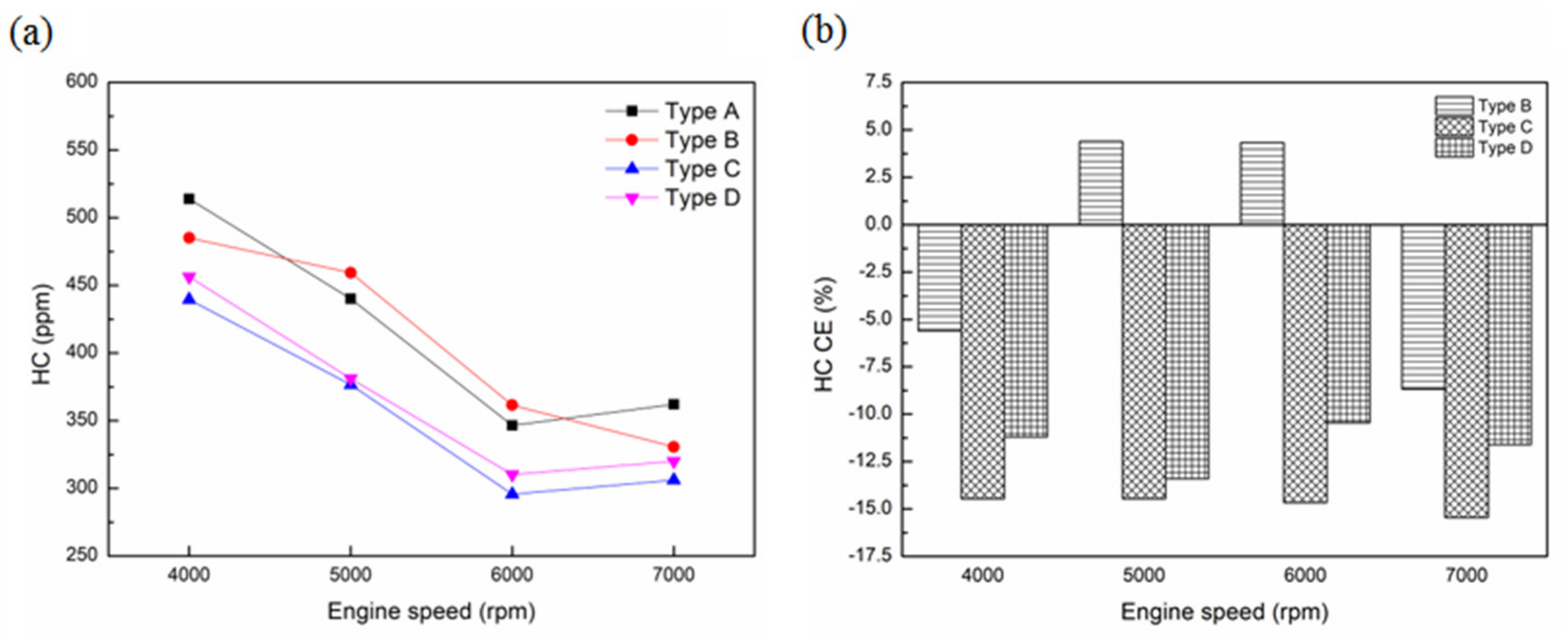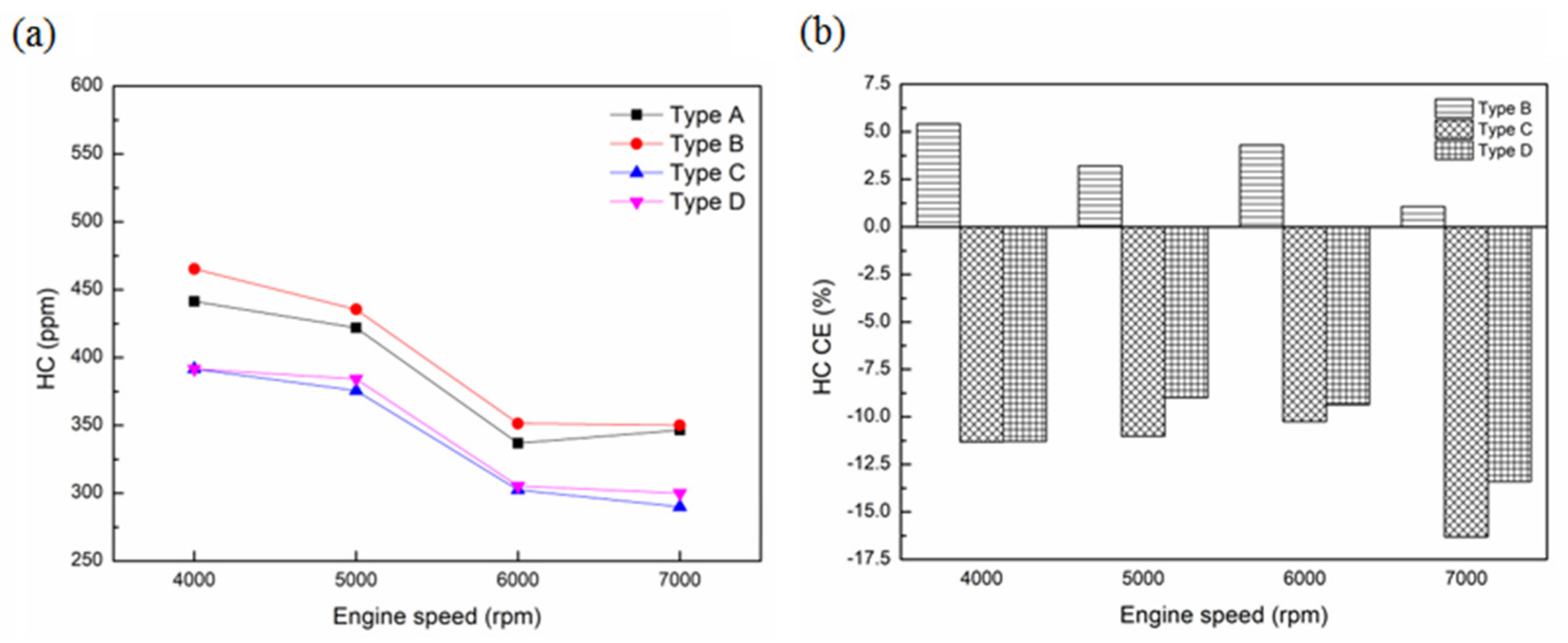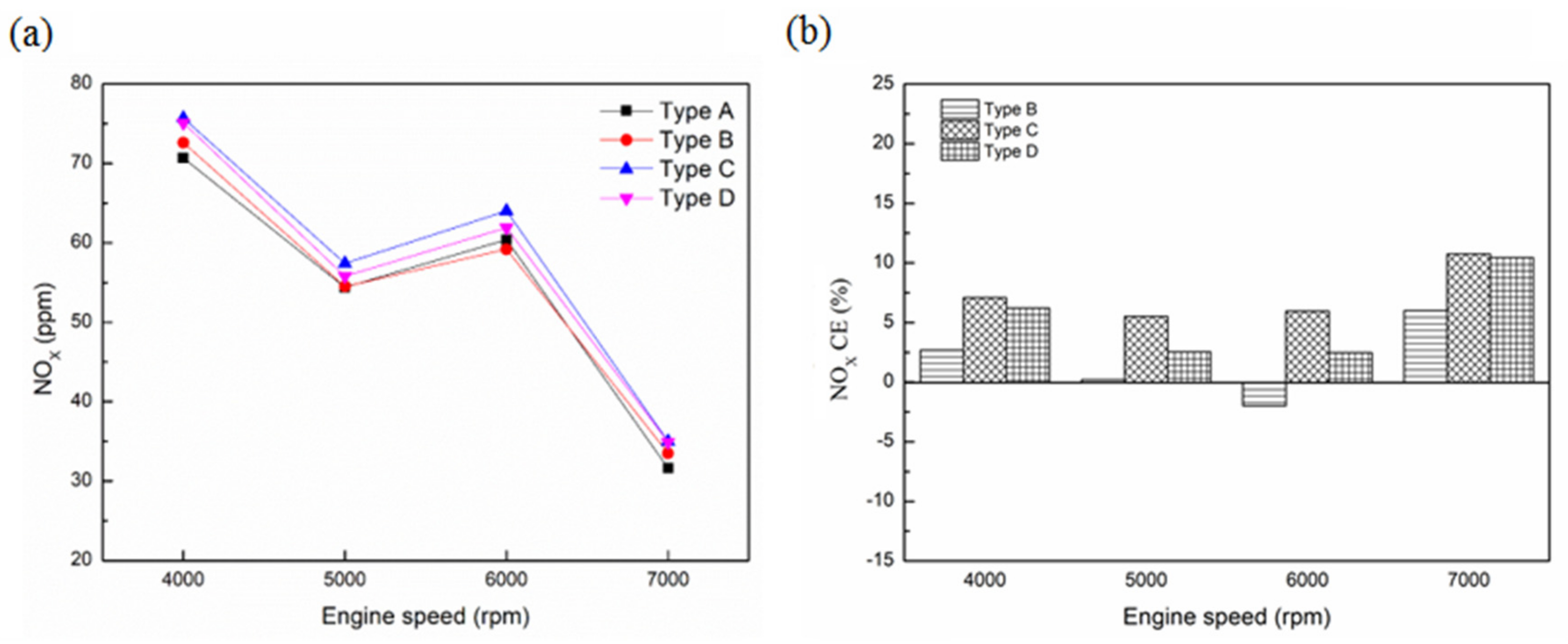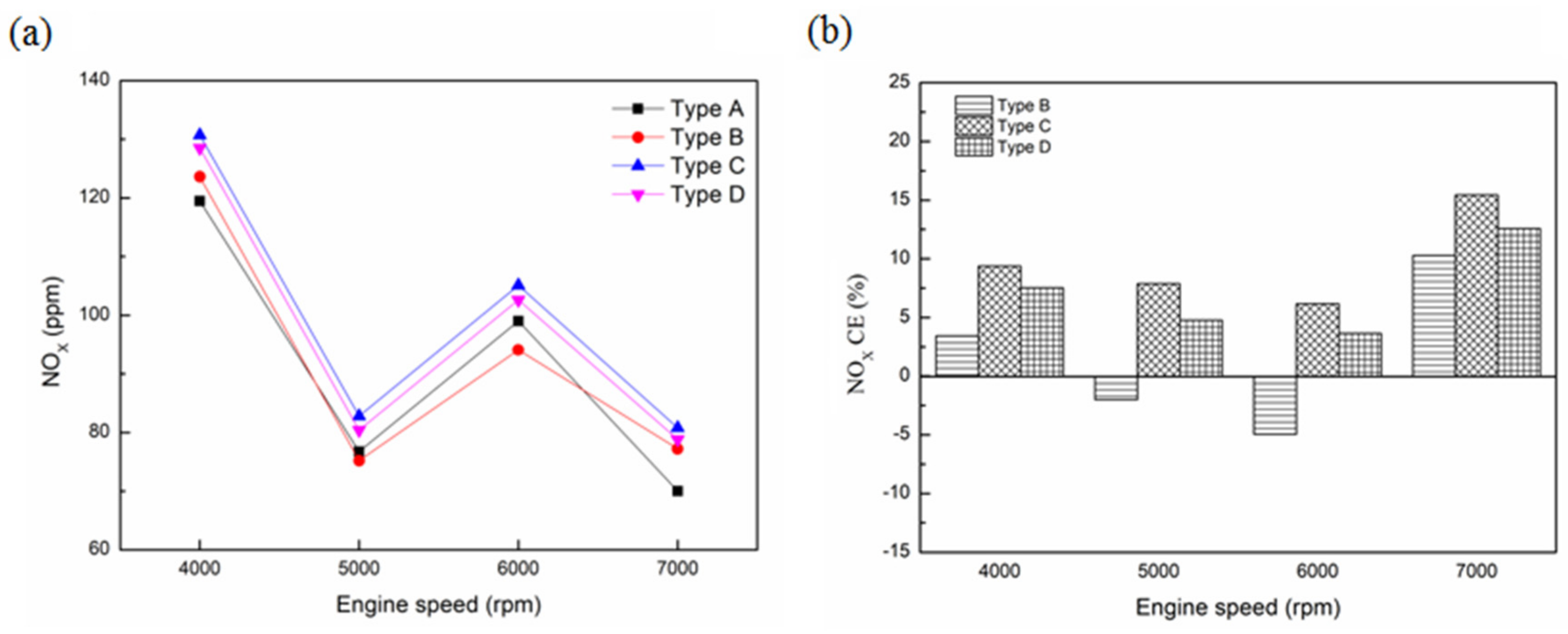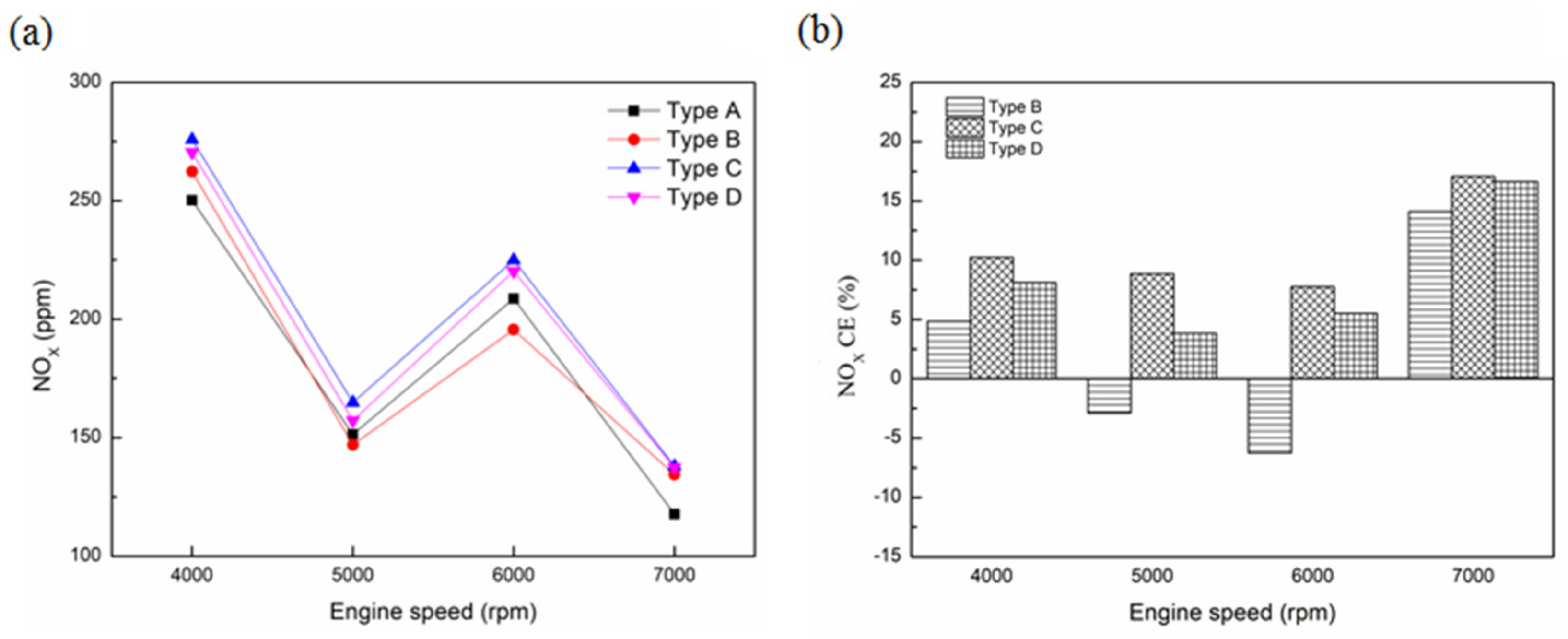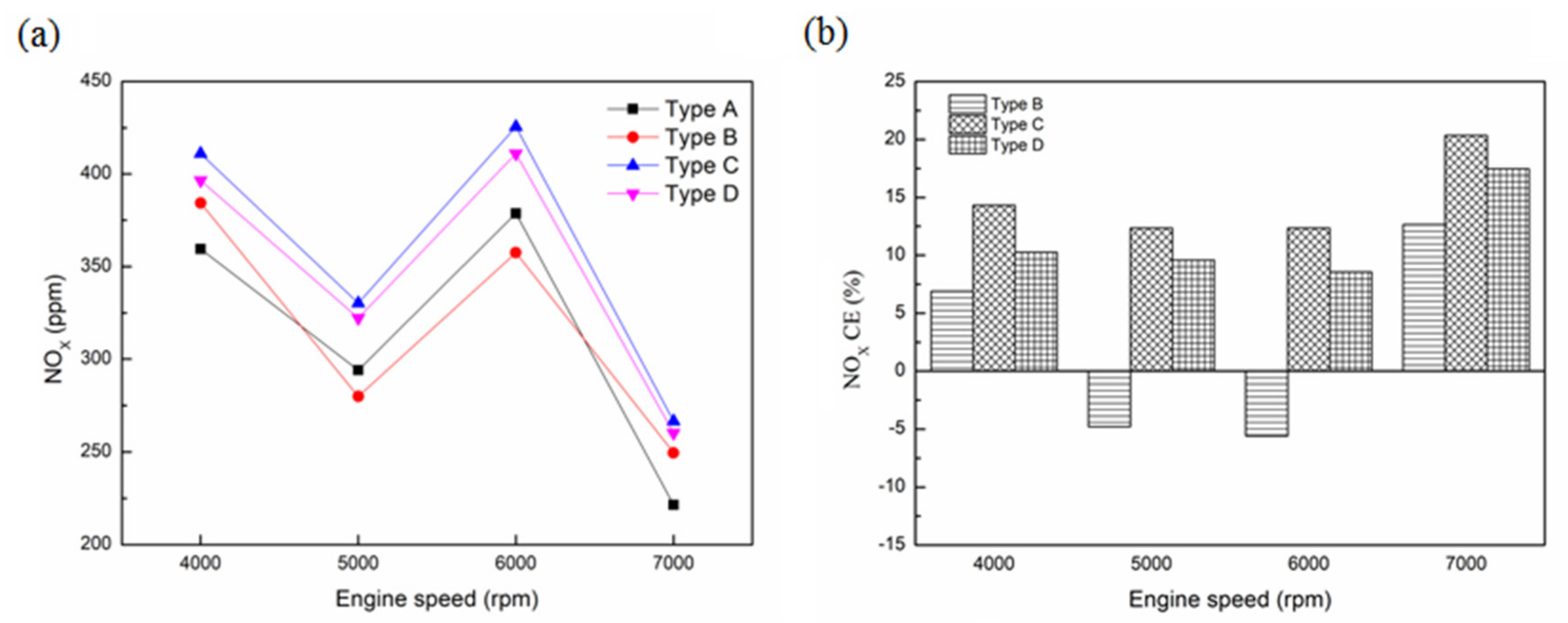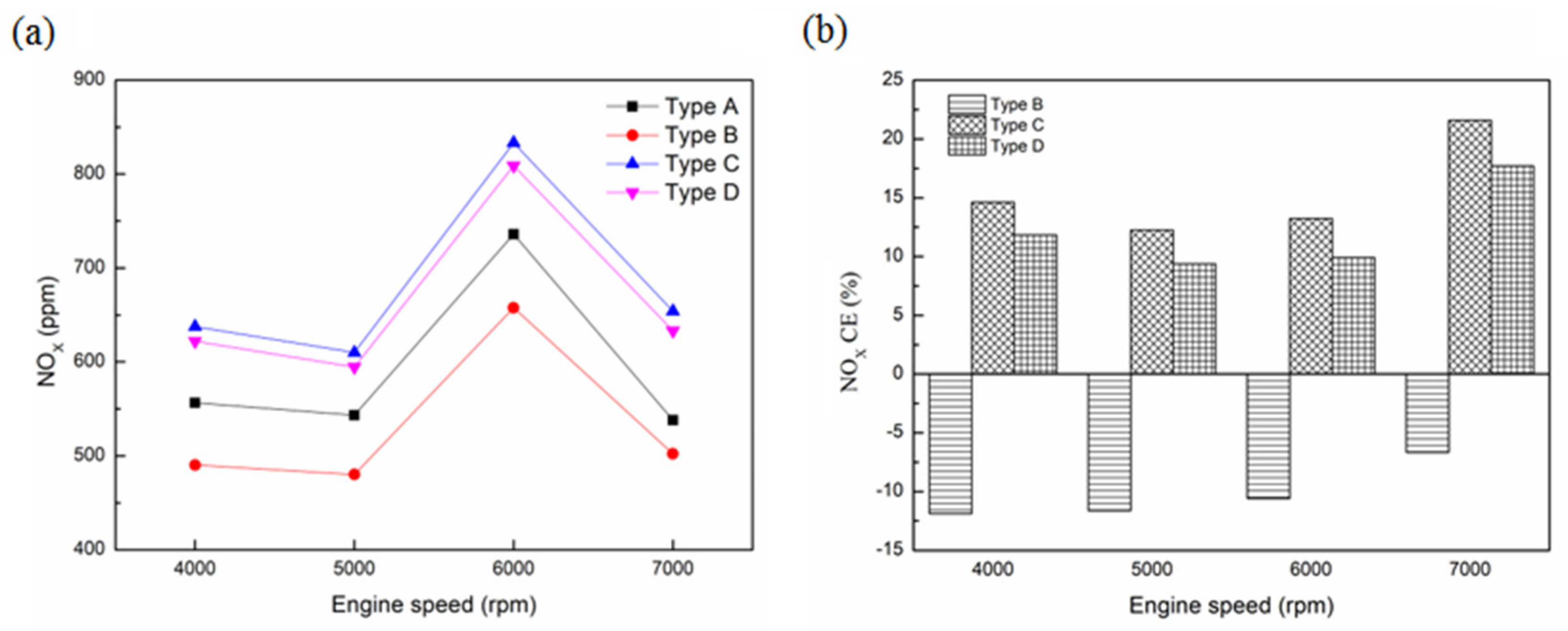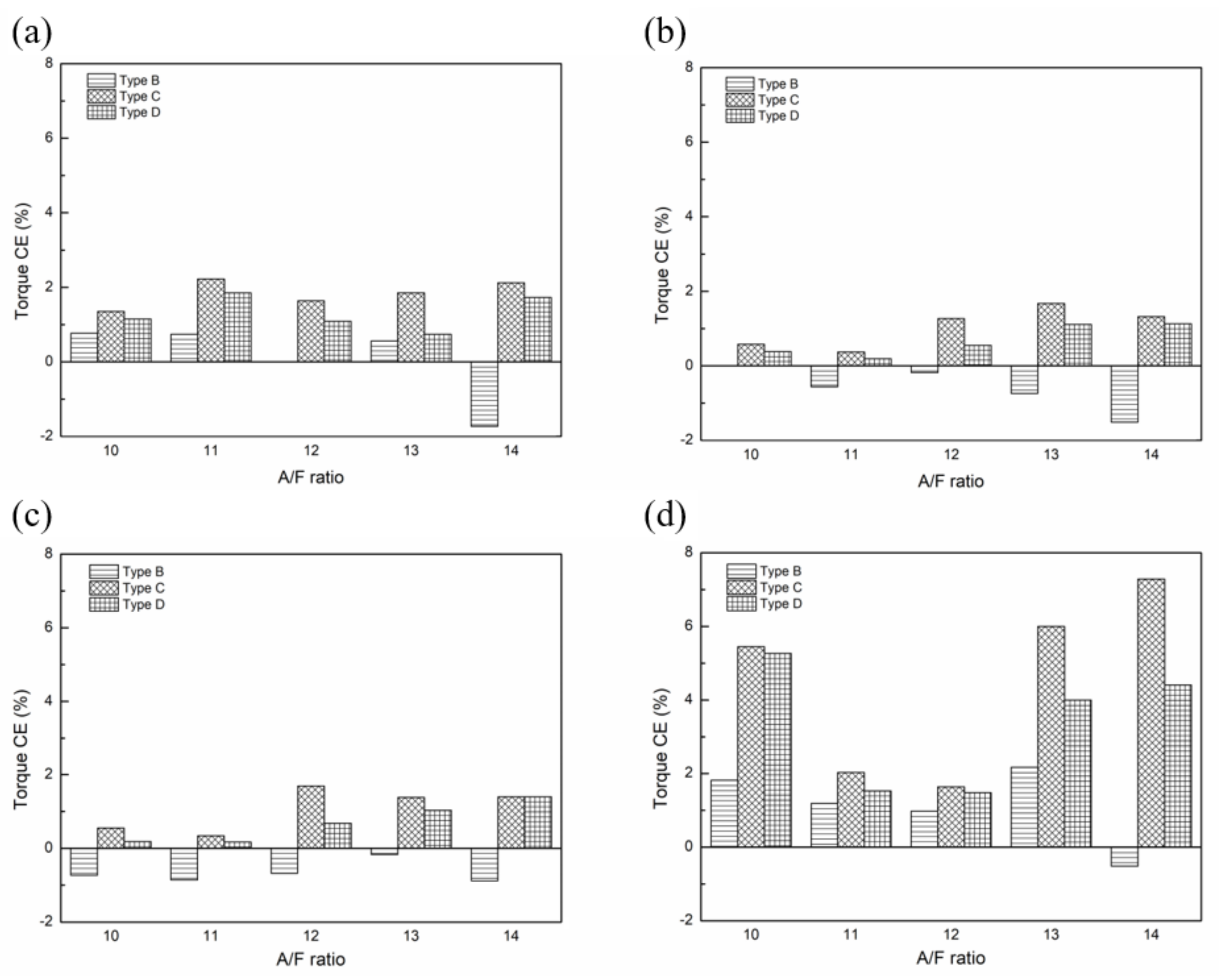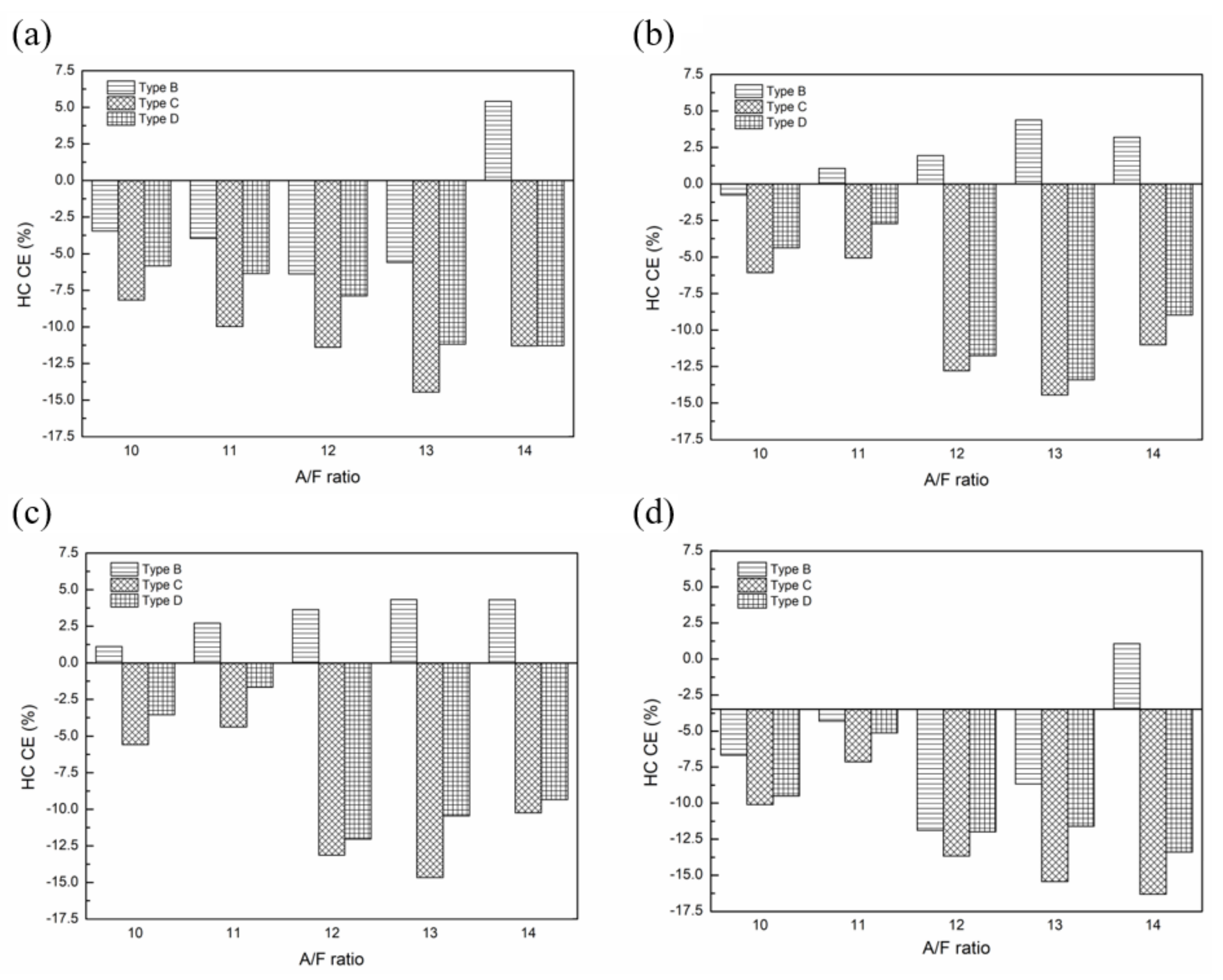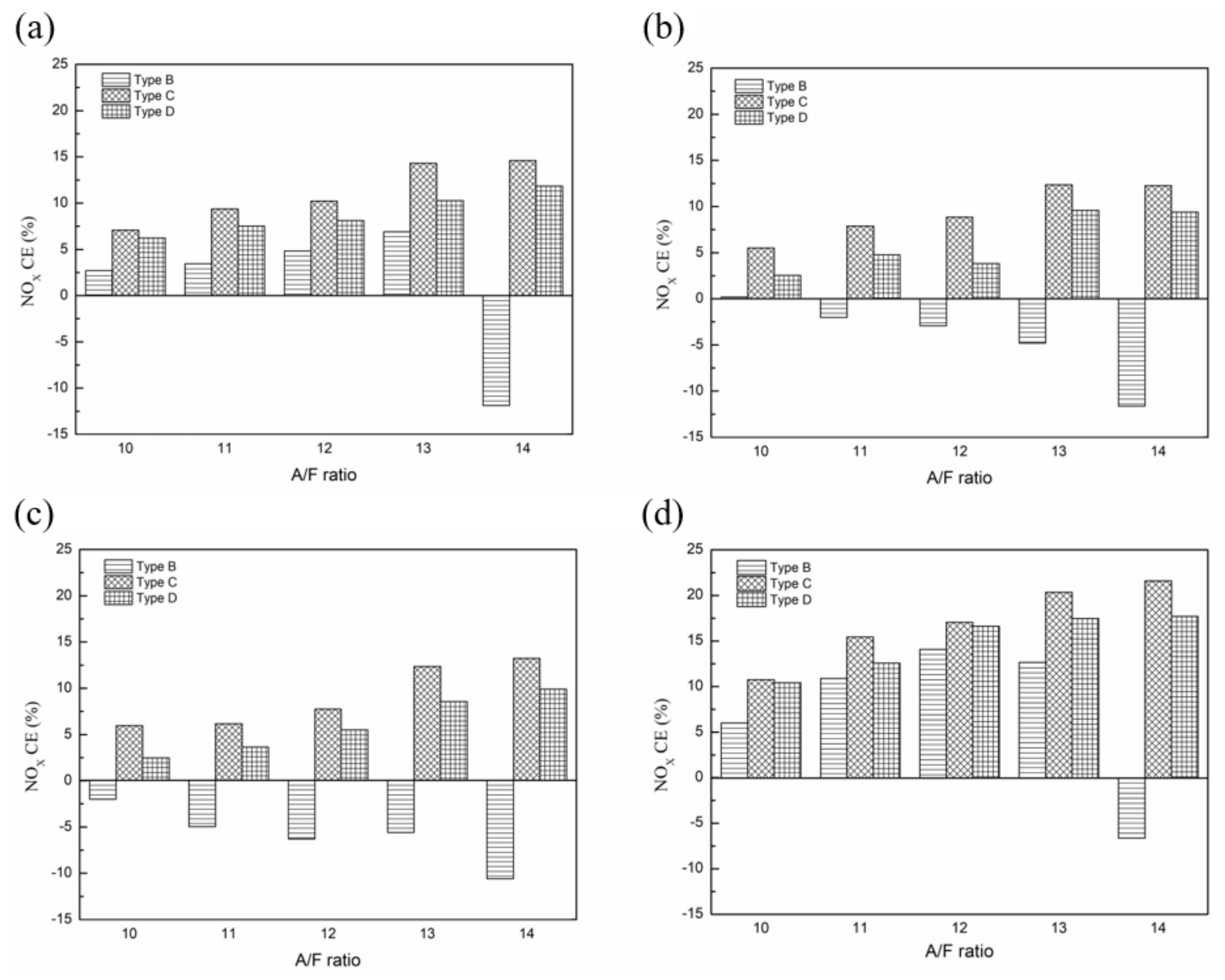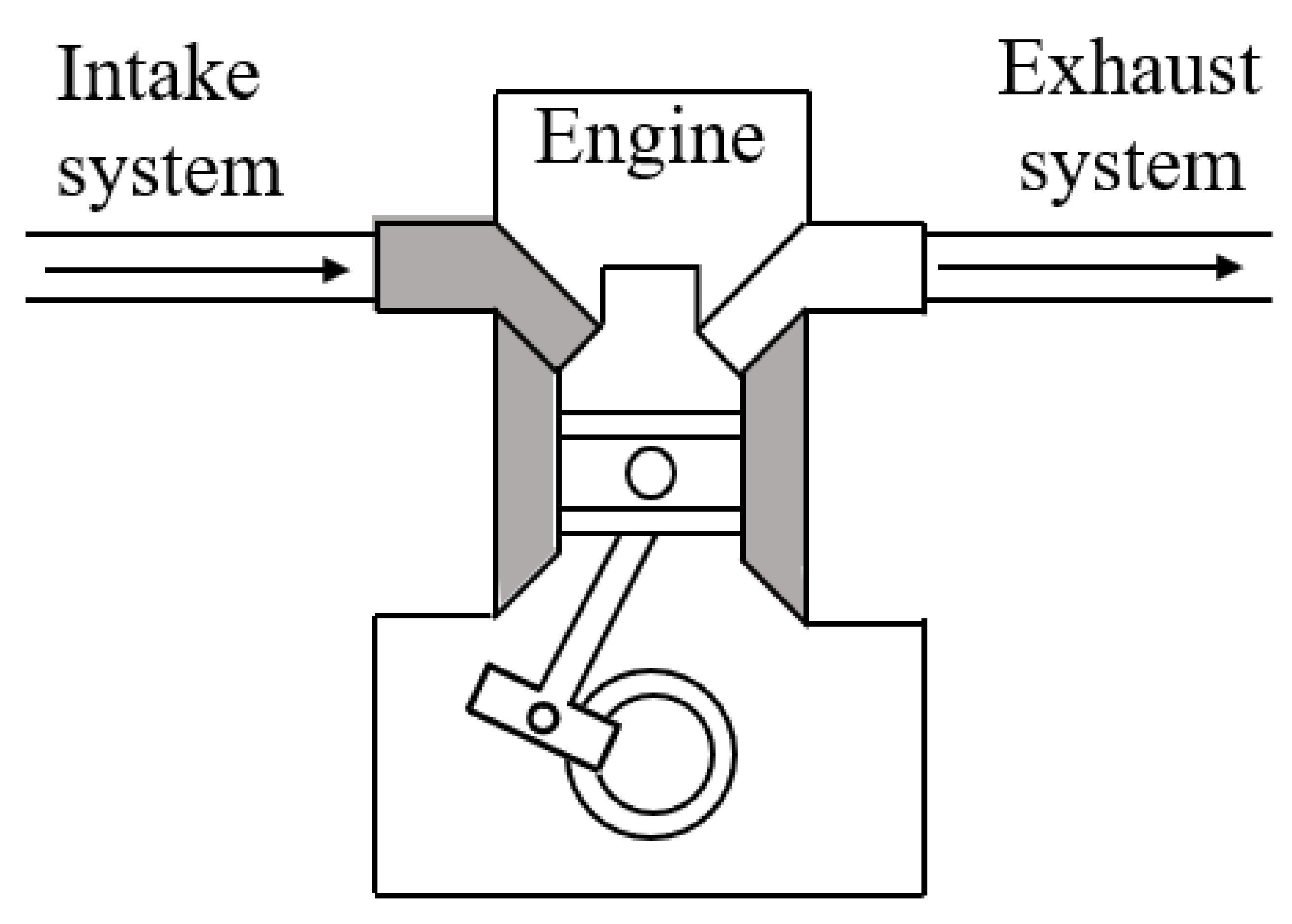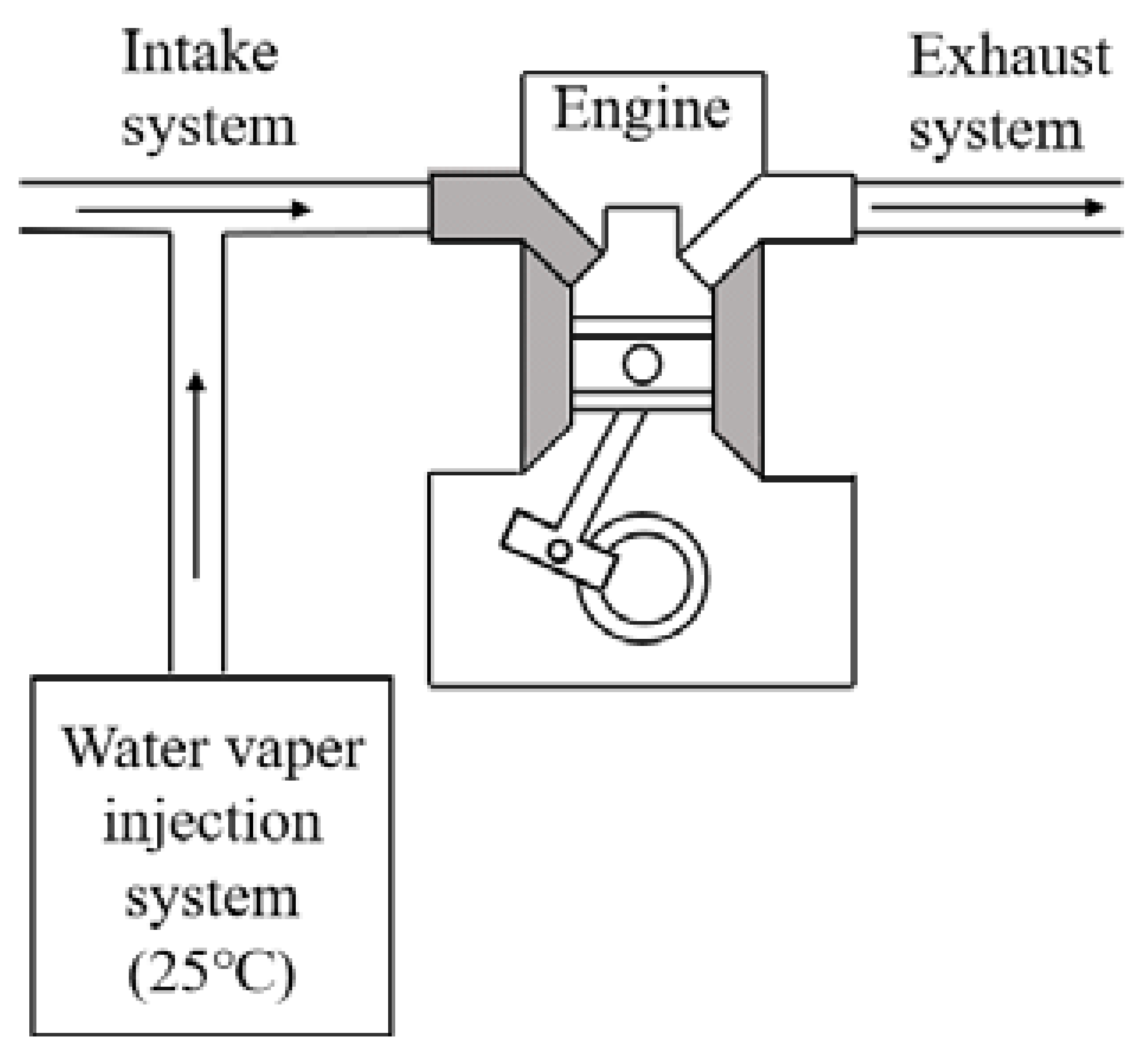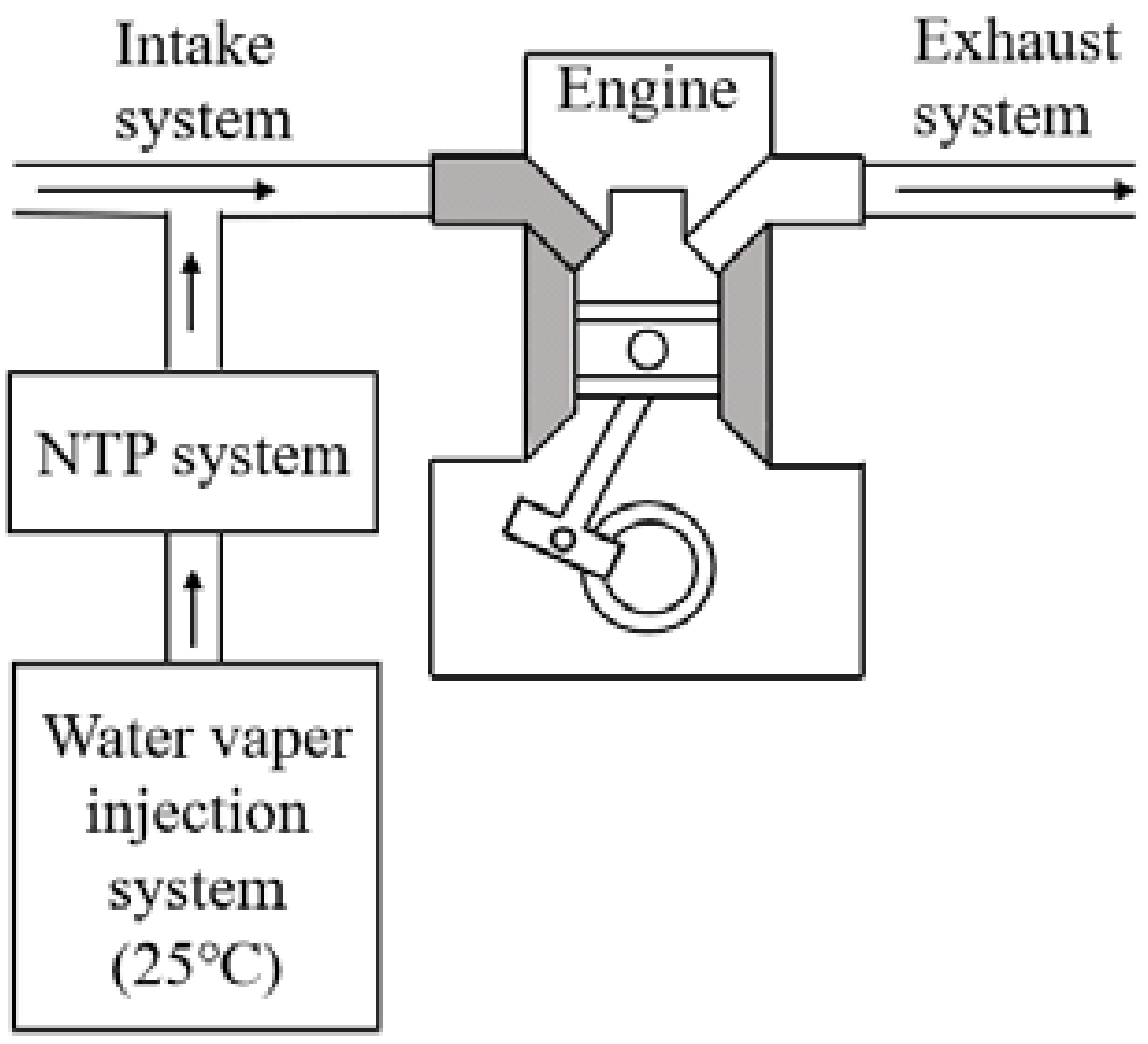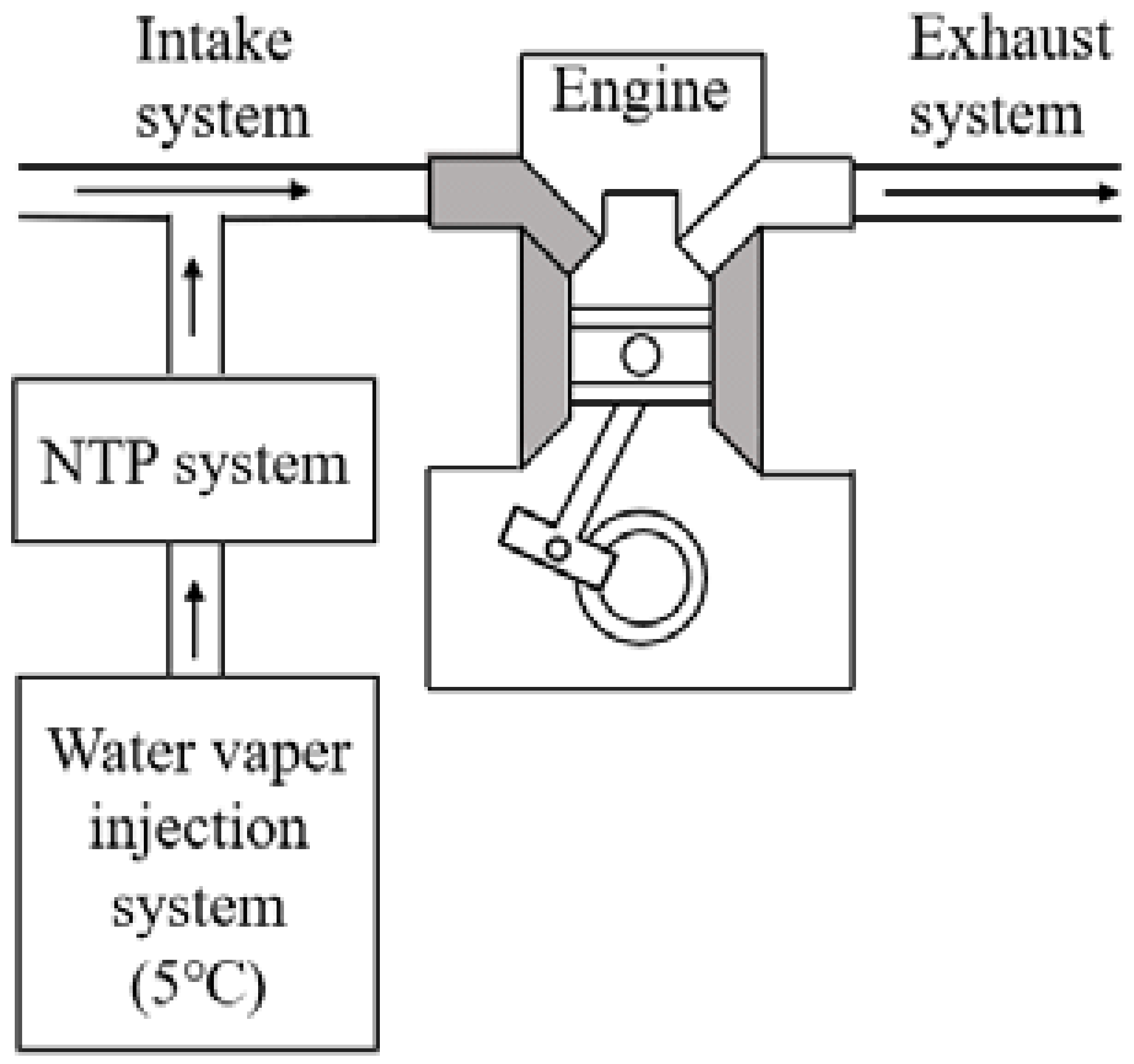The Internal Combustion Engine (ICE) is the main power source in the transportation sector. It can be divided according to the types of ignition, namely, Compression Ignition (CI) and Spark Ignition (SI) engines. Meanwhile, in the transportation sector, fossil fuel combustion is considered the primary source of energy. Fuel combustion produces a combination of chemical energy, thermal energy, and exhaust gas. In recent years, the world has begun to face crises concerning environmental degradation and fossil fuel depletion. Yet, despite the increased sales and improved performance of electric vehicles, there is an increasing sales trend in automobiles and motorcycles using conventional combustion engines in Taiwan. Furthermore, from 2010 to 2020, the number of fuel automobiles increased by 17.8%, electric automobiles by 2291%, fuel motorcycles by 51.9%, and electric motorcycles by 1074% [
1]. The exhaust emissions from these vehicles using conventional combustion engines are currently one of the main sources of air pollution. Meanwhile, the ongoing changes in legislation by governments around the world are resulting in an increasingly stringent range of vehicle exhaust gas emissions. The contaminants in exhaust gas include hydrocarbons (HC), nitrogen oxide (NOx), carbon monoxide (CO), and carbon dioxide (CO
2) [
2], of which HC represents 38%, NO
x represents 41%, and CO represents 70% of the global emissions [
3,
4]. The greenhouse effect is worsened by a great increase in the amount of CO
2, consequently resulting in global warming. On the other hand, the NO
x in the environment may be harmful to human health as it forms smog, which induces lung diseases. Since the NO
x emission from motorcycle engines was measured separately in 2008 for the first time, the NO
x emission has become particularly critical in Taiwan [
5]. Based on the above premises, the search for finding useful methods in reducing exhaust gas emissions and improving engine performance is intensified. Several studies have illustrated that mixed fuels could effectively improve performance and emissions. In light-duty CI engines, the fuel mixture composed of diesel, gasoline, and ethanol, has been utilized and studied to reduce soot and CO
2 and improve engine efficiency [
6]. Further, a fuel mixture composed of methane and diesel has been studied in a CI engine to reduce NO
x and CO
2 and improve the gross indicated efficiency [
7]. Meanwhile, a fuel mixture composed of bioethanol and gasoline has also been studied in SI engines to reduce energy loss, exergy loss, and exergy destruction rates [
8]. No major alterations to mechanical configurations were required by these methods.
1.1. Water Injection
Water has long been considered a good engine coolant. Thus, the Water Injection (WI) method is used to control emissions and as a knock suppressant. It can economically reduce exhaust gas emissions while improving engine performance [
9]. A WI application is not a new concept in ICE, and the first successful use could be traced back to the early 1930s [
10]. During World War II, WI was a key enabler of high-output aircraft engines. Although WI technology was temporarily abandoned due to the emergence of more powerful engines, it has been reintroduced to explore its potential benefits on both Compression Ignition (CI) and Spark Ignitions (SI) engines in the pursuit of fulfilling the increasingly stringent emission regulations. One effect of WI on engines, called the water thermal effect, is the cooling of the intake device and the spark’s temperature. Due to the specific heat capacity of water and the high latent heat of vaporization, this effect consequently decreases flame temperature [
11]. Another effect is the cooling of the intake charge, called the dilution effect. It is prompted by the enhanced mixing of fuel and air before combustion begins, leading to a reduction in the fuel enrichment area and soot formation [
12]. Information on the advantages of various methods in injecting water into engine combustion systems shows that there are three ways to supply water in an internal combustion system: (1) by directly injecting water into the engine through the intake manifold; (2) by indirectly injecting water into the engine through a nozzle; and (3) by injecting water directly into the engine through a fuel injection nozzle. Notably, the cheaper and easiest way to add water to an engine is the WI method through the intake manifold.
Ryu et al. (2004) investigated the effects of water induction through the air intake system on the combustion characteristics and the exhaust emissions in an IDI diesel engine [
13]. The results disclosed that NO
x formation was significantly suppressed by decreasing the gas peak temperature during the initial combustion process. Additionally, the NO
x emissions were also significantly diminished as the amount of water increased. On the other hand, Ma et al. (2014) investigated the effects of the Intake Manifold Water Injection (IMWI) on the characteristics of NO
x and soot emissions for diesel engines [
14]. The results signified that the IMWI could reduce the in-cylinder mean pressure and temperature, and the ignition delay could be lengthened, leading to a remarkable drop in NO
x and soot emissions. Kim et al. (2015) investigated the effects of direct water injection on engine performance and gasoline engine emissions [
15], featuring a compression ratio of 13.5. The subsequent result revealed that water effectively reduced the in-cylinder and exhaust gas temperatures. An increase in the injected water mass induced a further spark advance without the occurrence of knocking and provided some room for a further reduction in brake-specific fuel consumption. Meanwhile, Nour et al. (2017) investigated the effects of adding an ethanol/water mixture to diesel fuel combustion through the use of a rapid compression machine and diesel engine [
16]. The result showed that the ethanol/water blend injection contributed to an increase in the peak cylinder pressure, signifying a mean effective pressure and an apparent heat release rate at the premixed combustion phase. Furthermore, the ignition delay increased as ethanol/water mixture was added, followed by a decline in NO
x emissions by up to 88% and a reduction in soot by 50%. Kumar et al. (2018) investigated how the knock limit would be extended by injecting water and ethanol at the intake manifold while analyzing the engine’s performance, emission, and combustion characteristics [
17]. The result showed that the dual-fuel operation increased the BTE (Brake Thermal Efficiency) from 25.2% with neat Mahua longifolia oil to the maximum of 28.5% and 30%, respectively. Marchitto et al. (2018) investigated the effect of water injection on fuel efficiency and particle number emissions in a turbo-charged SI engine [
18]. WI was found to have stopped mixture over-fueling and improved fuel efficiency without engine load penalties. The higher knock tolerance and better combustion phasing allowed by the water injection led to a significant reduction in particle emissions.
1.2. Non-Thermal Plasma
The employment of Non-Thermal Plasma (NTP), which has a non-thermal equilibrium state, in various industries has increased. Room temperature is the lowest temperature of gasoline. Meanwhile, plasma species can reach temperatures of 10,000–100,000 K (1–10 eV), the highest [
19], which are chemically active and can form new stable compounds. In addition, these reactive species can be used in various applications, such as fuel gas [
20], fuel synthesis [
21], surface modification [
22], wastewater treatment [
23], and assisting in combustion [
24]. NTP systems are considered an important strategy in recovering exhaust pollutants, given that plasma chemical reactions convert these pollutants into less harmful species and remove contaminants. Various NTP systems have been extensively investigated to degrade exhaust gases, including the spark, dielectric barrier discharges, gliding arc, corona, microwave, and glow [
25,
26].
Janda et al. (2016) investigated the generation of NO
x in a DC-driven self-pulsing (1–10 kHz) Transient Spark (TS) discharge [
27]. The results demonstrated that the NO
2/NO ratio decreased along with an increase in TS repetition frequency. Notably, this decrease was related to the complex frequency-dependent discharge properties, thus changing the NO
2/NO-generating mechanisms. Bahri et al. (2017) investigated the removal of gas-phase VOCs by an NTP-catalytic reactor in both dry and humid conditions [
28], indicating a high removal efficiency in isobutanol (100%) and toluene (∼90%) in dry air conditions. Further, Kim et al. (2017) investigated the effects of NTP on a lean premixed model gas turbine combustor of NO
x and CO by changing the mixing nozzle exit velocity and equivalence ratio [
29]. The result indicated a significant increase in intensity in the flame-enhanced streamer. The CO emissions were reduced, while the NO
x emissions were increased due to complete burning. Mohapatro et al. (2017) investigated the effects of high voltage pulses by using compact power supply sources on the NO
x emissions of diesel engines [
30]. The result showed that while the flow rate was maintained at 2 L/min, the maximum efficiency of the cylindrical electrode was 86%. Meanwhile, Hwang et al. (2017) investigated the effect of microwave-assisted plasma ignition on the combustion and emission characteristics in a 500 cm
3 single cylinder direct injection gasoline engine [
31]. The result demonstrated that this type of ignition had a more advanced combustion phase than the conventional spark ignition and that the fuel efficiency was improved by 6%. Moreover, the CO and HC concentrations in the exhaust were reduced. Hsueh et al. (2020) investigated the variation of toxic contaminants of an internal gasoline engine’s exhaust system by adopting the NTP system in the exhaust pipe [
32]. Noteworthily, subsequent results disclosed that the NTP system could greatly reduce toxic contaminants.
Although several studies have been currently conducted on the application of WI in internal combustion engines [
33], there is minimal experimental research done on the effects of water vapor injection and NTP systems on engine performance and exhaust emissions. Meanwhile, most existing studies employed a fixed engine speed and air/fuel (A/F) ratio. Based on the SI engine, this study explored the effects of changing engine speeds and A/F ratios on engine performance and exhaust emissions by installing a water vapor injection and NTP system on the intake manifold. This strategy aimed to reduce thermal effects, such as the chemical and dilution effects of water vapor on the engine, expecting to reduce exhaust gases and increase engine performance by increasing the density of free radicals. The bubbler tank’s water temperature was controlled by a temperature control device, and the water was divided into ice water and water at room temperature. The voltage of the NTP system was set at 5 V. An engine performance test was adapted to analyze the correlation of the water temperature in the bubbler tank and the engine output under various engine speeds and A/F ratios. Exhaust emissions were measured at different engine speeds and A/F ratios to find the effects of water temperature in the bubbler tank.
